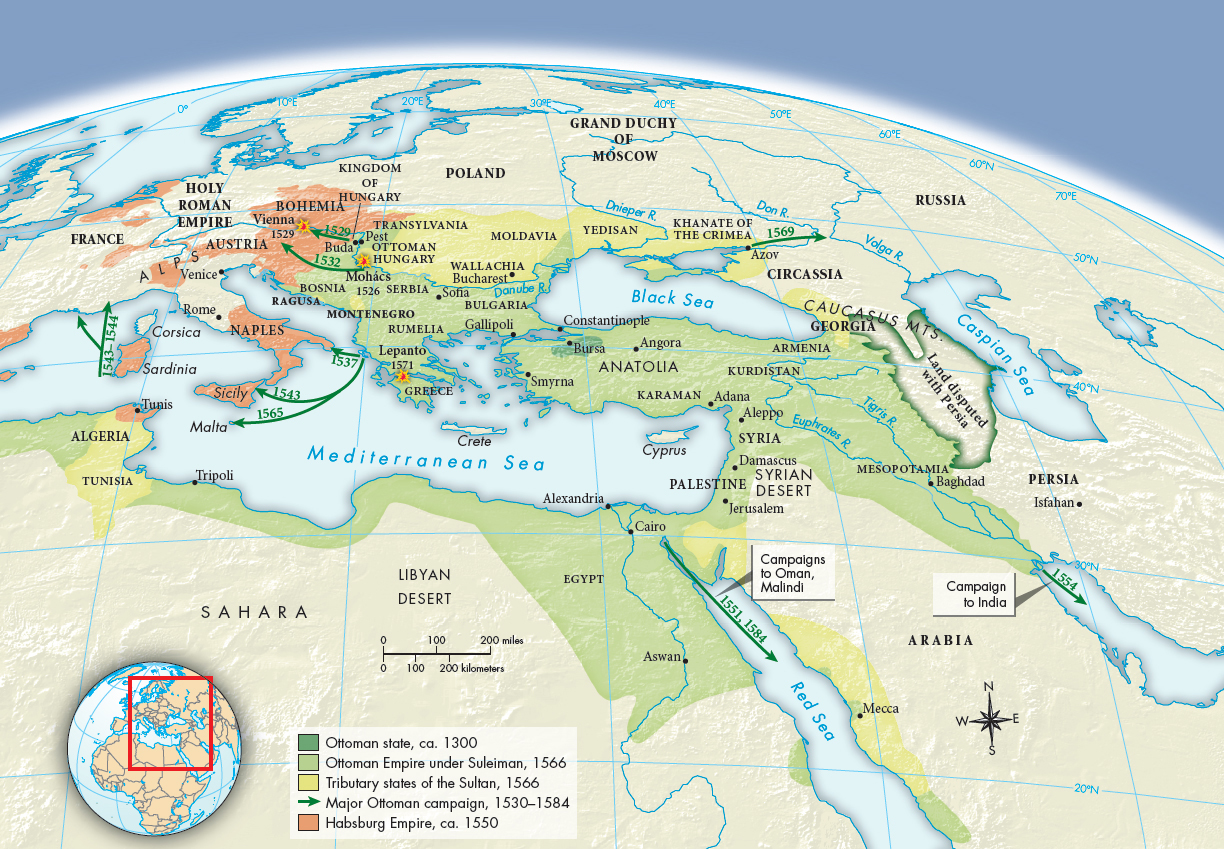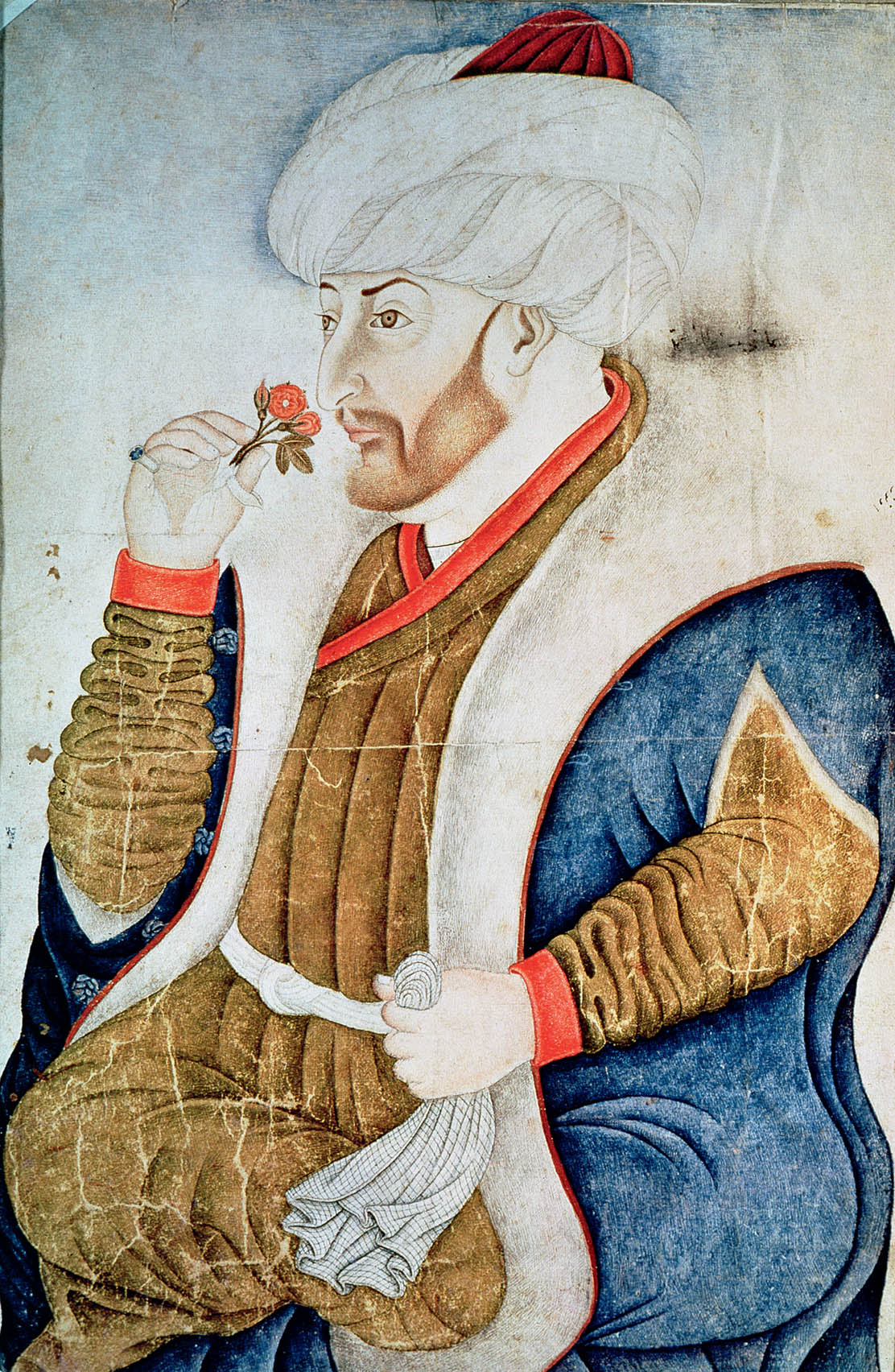The Expansion of the Ottoman Empire
The Ottomans took their name from Osman (r. 1299–

Osman’s campaigns were intended to subdue, not to destroy. The Ottomans built their empire by absorbing the Muslims of Anatolia and by becoming the protector of the Orthodox Church and of the millions of Greek Christians in Anatolia and the Balkans. In 1326 they took Bursa in western Anatolia, and in 1352 they gained a foothold in Europe by seizing Gallipoli. Their victories led more men, including recent converts, to join them as ghazis. In 1389 at Kosovo in the Balkans, the Ottomans defeated a combined force of Serbs and Bosnians. And in 1396 on the Danube River in modern Bulgaria, they crushed King Sigismund of Hungary, who was supported by French, German, and English knights. After the victories in the Balkans, the Ottomans made slaves of many captives and trained them as soldiers. These troops were outfitted with guns and artillery and trained to use them effectively.
In 1453, during the reign of Sultan Mehmet II (r. 1451–

Once Constantinople was theirs, the Ottoman sultans considered themselves successors to both the Byzantine and Seljuk Turk emperors, and they quickly absorbed the rest of the Byzantine Empire. In the sixteenth century they continued to expand through the Middle East and into North Africa.
To begin the transformation of Constantinople (renamed Istanbul) into an imperial Ottoman capital, Mehmet ordered wealthy residents to participate in building mosques, markets, fountains, baths, and other public facilities. To make up for the loss of population through war, Mehmet transplanted inhabitants of other territories to the city, granting them tax remissions and possession of empty houses. He wanted them to start businesses, make Istanbul prosperous, and transform it into a microcosm of the empire.
Gunpowder, which was invented by the Chinese and adapted to artillery use by the Europeans, played an influential role in the expansion of the Ottoman state. In the first half of the sixteenth century, thanks to the use of this technology, the Ottomans gained control of shipping in the eastern Mediterranean, eliminated the Portuguese from the Red Sea and the Persian Gulf, and supported Andalusian and North African Muslims in their fight against the Christian reconquest of Muslim Spain. In 1514, under the superb military leadership of Selim (r. 1512–
Suleiman (r. 1520–
In eastern Europe to the north of Ottoman lands stood the Grand Duchy of Moscow. In the fifteenth century Ottoman rulers did not regard it as a threat; in 1497 they even gave Russian merchants freedom of trade within the empire. But in 1547 Ivan IV (the Terrible) brought the entire Volga region under Russian control (see Map 17.1). In 1557 Ivan’s ally, the Cossack chieftain Dimitrash, tried to take Azov, the northernmost Ottoman fortress. Ottoman plans to recapture the area succeeded in uniting Russia, Persia, and the pope against the Turks.
Though usually victorious on land, the Ottomans did not enjoy complete dominion on the seas. Competition with the Habsburgs and pirates for control of the Mediterranean led the Ottomans to conquer Cyprus in 1570 and settle thousands of Turks from Anatolia there. (Thus began the large Turkish presence on Cyprus that continues to the present day.) In response, Pope Pius V organized a Holy League against the Turks, which won a victory in 1571 at Lepanto off the west coast of Greece with a squadron of more than two hundred Spanish, Venetian, and papal galleys. Still, the Turks remained supreme on land and quickly rebuilt their entire fleet.
To the east, war with Safavid Persia occupied the sultans’ attention throughout the sixteenth century. Several issues lay at the root of the long and exhausting conflict: religious antagonism between the Sunni Ottomans and the Shi’a Persians, competition to expand at each other’s expense in Mesopotamia, desire to control trade routes, and European alliances. (For more on the Shi’a faith, see “The Safavid Empire in Persia.”) Finally, in 1638 the Ottomans captured Baghdad, and the treaty of Kasr-
The Ottoman political system reached its classic form under Suleiman I. All authority flowed from the sultan to his public servants: provincial governors, police officers, military generals, heads of treasuries, and viziers. In Turkish history Suleiman is known as “the Lawgiver” because of his profound influence on the civil law. He ordered Lütfi Paşa (d. 1562), a poet and juridical scholar of slave origin, to draw up a new general code of laws that prescribed penalties for routine criminal acts such as robbery, adultery, and murder. It also sought to reform bureaucratic and financial corruption, such as foreign merchants’ payment of bribes to avoid customs duties, imprisonment without trial, and promotion in the provincial administration because of favoritism rather than ability. The legal code also introduced the idea of balanced government budgets. The head of the religious establishment was given the task of reconciling sultanic law with Islamic law. Suleiman’s legal acts influenced many legal codes, including that of the United States. Today, Suleiman’s image appears in the chamber of the U.S. House of Representatives, along with the images of the Athenian lawmaker Solon, Moses, and Thomas Jefferson.
The Ottomans ruled their more distant lands, such as those in North Africa, relatively lightly. Governors of distant provinces collected taxes and maintained trade routes, but their control did not penetrate deeply into the countryside.